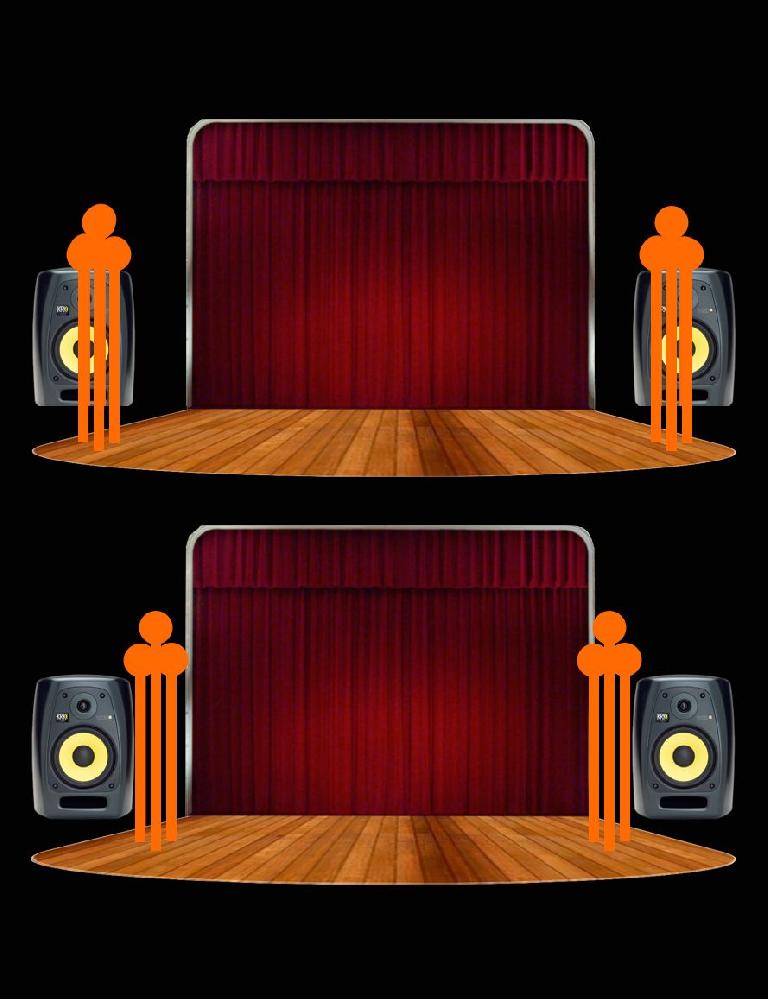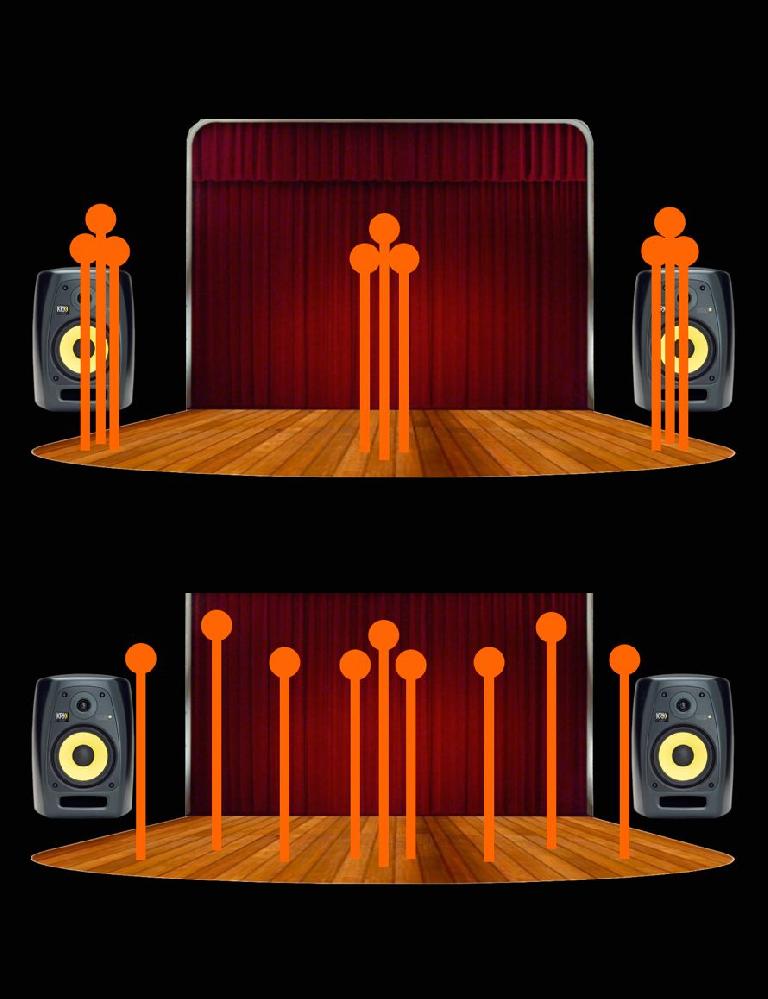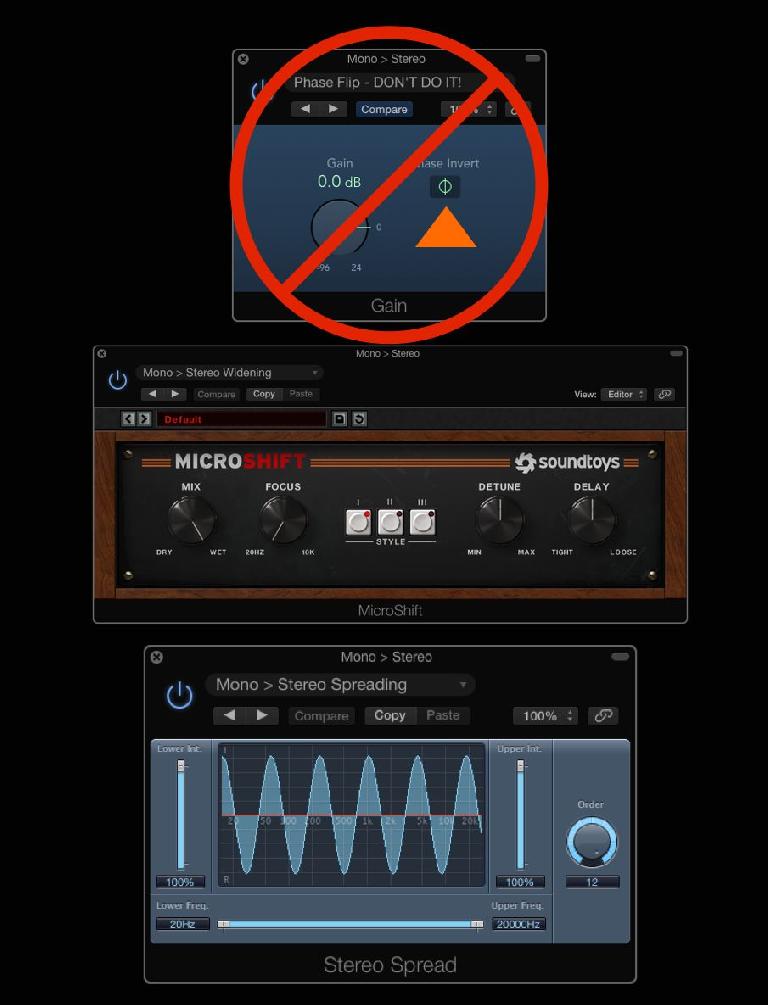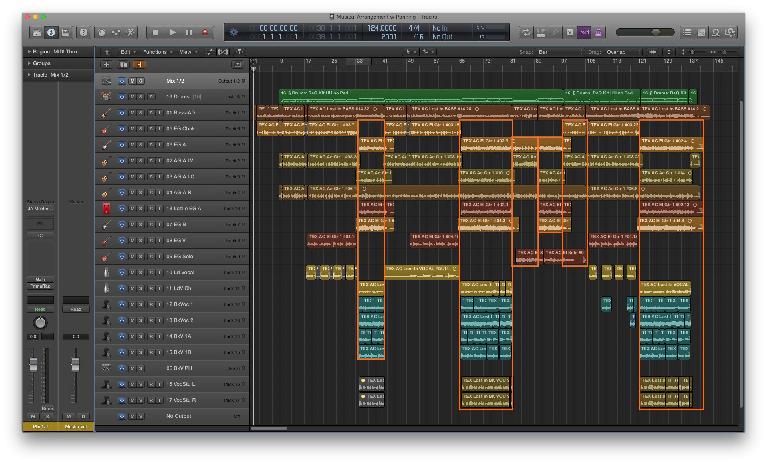As we get caught up in using all the wonderful tools available for mixing in the modern world, sometimes it’s easy to overlook the most basic. After level adjustments, panning—positioning different tracks between left and right in the stereo soundfield—is one of those basic mixing tasks that contributes a lot more than it may seem. And while panning is a pretty straightforward mix move, it’s still possible to do a less-than-optimum job of it. This article covers 7 things to look out for—potential positioning pitfalls when panning, that could contribute to a less-than-perfect mix.
1. Don’t Hard-Pan
Basic panning in a DAW is amplitude-based—a (mono) track is sent to both the left and right sides of the stereo master, and the Pan Pot (Panoramic Potentiometer, for the technophile) adjusts the relative levels between left and right. At center, left and right levels are equal; panning to the left or right simply turns up the level to one side while simultaneously turning down the level to the other. Pan positions in the center or part of the way between left and right have sound coming out of both speakers—even though the signal seems to be positioned at a particular spot between the speakers, it’s a phantom position—an illusion.
Naturally, there will be slight phase differences between the two actual signal sources, and this is a normal part of amplitude-based stereo panning. But if you pan all the way left or right—“hard” left or right—then that signal will be coming out of only one speaker. A track with only a single physical sound source may not sit in the mix as well as the rest, with their dual sound sources and slight phase differences. Such hard-panned tracks can sometimes stick out of the mix, and sound more two-dimensional—like they’re coming out of the box—the speaker—rather than being positioned in the virtual three-dimensional soundfield between the speakers, with the other tracks. Many mixers avoid this by panning around 90% left or right (when they want a very wide pan position) rather than 100% (hard panning).
This maintains at least a little sound in both speakers, and keeps those wide-panned tracks in the virtual soundfield, where they’ll blend better with the rest of the mix. (Incidentally, the same issue comes up regarding the use of the center channel when mixing music in Surround).
2. Don’t Bunch Up
In smaller studios, sometimes the speakers may be positioned fairly close together, and when a mixer wants different tracks to be clearly separated at different positions, this can lead to the tendency to pan things to the center, far left, and far right only. But a mix with this kind of panning, when played on a set of speakers that are more widely positioned (at, say, the recommended 60° angle), may end up having “holes” in the left-right soundfield—gaps around the half-left and half-right positions, with all the instruments and vocals bunched up at the far left, far right and center spots.
Psychoacoustically, this mix won’t achieve as much clarity and detail as it could—even though the apparent source position of panned tracks is an illusion, the subtle increase in clarity and detail from assigning different tracks to slightly different locations in the left-right spread is real. It pays to make sure to space the mix speakers at the proper width (a 60° angle), and assign various tracks to slightly different virtual locations between the speakers—not just wide left, center, and wide right, but positions like 20%, 40%, 50%, 70%, 90%, etc., between center and either side, filling in the stereo spread. If it helps, imagine players on a stage, each one in his/her own spot, when constructing the virtual soundstage.
3. Don’t Confuse Stereo Panning and Balancing
The concept of panning is straightforward with mono tracks (as described above), but possibly less so with stereo tracks. Some DAWs feature two pan controls for each stereo track—one positions the left side of the signal, the other the right. For standard, full stereo, these would be set hard left and right (which is fine—since it’s a stereo signal, there will be audio coming out of both speakers). Alternatively, you could reverse the image—pan the right side hard left and vice versa. Or you could partially-pan the stereo audio (e.g. Left: 50% left / Right: 50% right), for a narrower stereo image, or pan one side and leave the other at or near center (e.g. Left: 100% left / Right: 0%-Center), for a non-centered but still somewhat wide stereo image. This is the most flexible way of implementing stereo panning, as it’s done in Pro Tools.
But other DAWs may take a different approach. For example, Logic features a single Pan control for both mono and stereo tracks—only it’s not really a Pan control on the stereo tracks, it’s actually as Balance control. A Balance control doesn't reposition the left and right sides of a stereo track—as the name suggests, it rebalances the relative levels of the two sides. So with true stereo panning, the relative levels of left and right are not changed, only the positions of each half of the audio. But if you “pan” a Balance control to one side or the other, you’ll be raising the level of that side of the stereo track and reducing the level of the other side. A stereo signal with both sides properly panned all the way left will become a mono signal containing both left and right sides. A stereo signal with a Balance control “panned” all the way left will consist of only the left side of the audio—not the same result at all!
Of course, a Balance control has its uses, but not as a substitute for a true stereo panner. It’s important to be aware of which you’re dealing with when confronted with a single “Pan” control on a stereo track. In the Logic example, if you wanted to actually stereo-pan your signal, you’d need to leave the channel strip balance knob at center, and instead open an (included) imaging plug-in (Direction Mixer), where you can perform the kinds of stereo adjustments I described above (that you could do more directly with the dual stereo Pan knobs in Pro Tools).
4. Don’t Phase-Flip for Fake Stereo
Sometimes, instead of panning a mono track in the mix, you may want to widen it—create an artificial stereo soundfield. This can be a good idea, and there are several ways to go about it, but also at least one technique that should be avoided. Possibly the easiest way to generate a stereo image from a mono track is to duplicate the track and flip the phase (actually reverse the polarity) of the copy. With two versions of the same signal, with opposite polarities, coming out of different speakers, you’ll get a wide, diffuse image. But you should never do this for a mix! It only works as long as the signal is always heard in stereo—if that mix is ever played back in mono (quite common even nowadays), the two reverse-polarity signals will cancel completely, and the track will disappear!
If you do want to generate fake stereo from mono, there are safer ways to go about it. You could duplicate the track, slightly pitch-shift (micro-shift) the two copies a few cents up & down, and delay the copy—a subtle form of widening that produces a broad image without necessarily sounding doubled. Or you could use one of the various frequency-based stereo imaging processors, that divide the signal into different frequency bands, and then pan adjacent bands left and right, for a subtly wider image.
As long as you avoid the phase/polarity-flip trick, you should be able to achieve a wider soundfield while still maintaining mono compatibility—but whatever approach you try, you should still always check it in mono anyway, before signing off.
5. Don’t Forget to Pan for the Song
When deciding on pan positions for the various tracks in a mix, it’s important to take into account how the arrangement changes throughout the song. I’ve seen novice mixers spend some time carefully adjusting pan positions while looping one section, only to realize that in other sections, the instrumentation changed enough to invalidate their choices at those points. Here’s an example…
You usually want to try to maintain a good overall left-right balance when assigning pan positions—that is, you don’t want to pan too many parts to, say the left side, with fewer arrangement elements on the right, making for an overly left-heavy mix (that may be uncomfortable to listen to, especially in headphones). But different parts may drop in and out in different sections of the song, and you need to address this. If you have, say, a keyboard part panned partly left that balances out a rhythm guitar part panned partly right in a verse, what happens if the guitar kicks into overdrive in the chorus, and the keyboard drops out, or is (intentionally) swamped in the musical mix?
In situations like this, you’ll need a more dynamic approach to panning. You could either create extra duplicate tracks, and divide and distribute the parts to these different tracks, panned appropriately to address changes in the arrangement from section to section, or you could, of course, use pan automation to accomplish the needed dynamic adjustments. You may prefer to avoid having a particular instrument or sound shift positions in different sections, but you can also employ selective doubling and stereo widening to maintain a good overall left/right balance, as the need arises (in my example, the guitar might be doubled or widened only in the chorus, with the copy filling in for the missing keyboard, avoiding a sudden dropout on one side of the mix).
There are no hard and fast rules for dealing with musical panning considerations like this—each song will likely present its own issues and solutions. But a little attention paid to it, as well as to the other panning issues I’ve described, may go a long way to achieving a better, clearer, more well-balanced mix.
Take your production knowledge to the next level with the video courses in The Ask.Audio Academy.







 © 2024 Ask.Audio
A NonLinear Educating Company
© 2024 Ask.Audio
A NonLinear Educating Company
Discussion
By "what happens" do you mean how might mono playback affect a mix made for stereo? Well, aside from the caveat about polarity-flipped fake stereo potentially canceling out in mono, in general, in mono playback you may lose some of the clarity you might have gained (thanks to the psychoacoustics of stereo hearing) by spreading the tracks out, and the center elements may be slightly more prominent, though the overall balance should still work just fine. The difference is usually subtle, and often not really a big cause for concern, but it was enough that when remastering the older Beatles catalog material that was originally mixed for mono distribution, there was much discussion about whether stereoizing those mixes was not being true enough to the originals, and they ended up releasing them both ways..
If mono reproduction may be a significant part of how the public first hears your music/mixes, then you might want to take a little extra time checking and possibly subtly tweaking a mix to insure that it will come across as well in mono as it does in stereo, just like we tweak a mix to work on different-sounding speakers and headphones -- there may be some small compromises, but it's part of the job when mixing for a commercial release to anticipate how the mix will sound on different playback systems in different environments, and make sure that while it sounds best in the primary format, it still works reasonably well even in less-than-ideal scenarios, of which mono playback might be one.
Btw, as you pointed out, this article is two years old, and re the comments about pan vs balance control in Logic, it’s worth noting that in the interim Logic introduced true stereo panning for stereo tracks, negating the need for the Direct Mixer in most cases. It uses one knob, but provides the same functionality as Pro Tools’ dual stereo pan knobs, and is well implemented.
Cheers,
Joe
Want to join the discussion?
Create an account or login to get started!